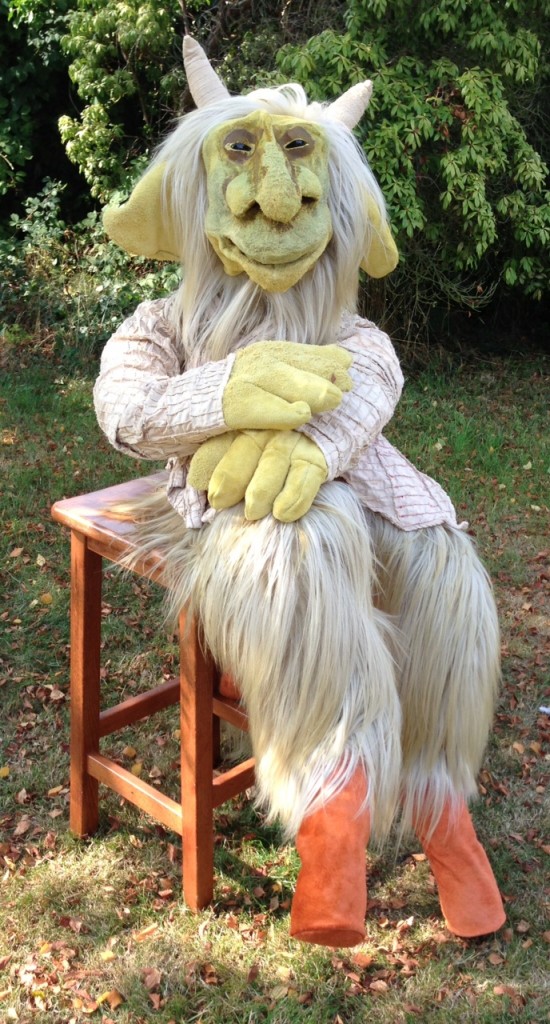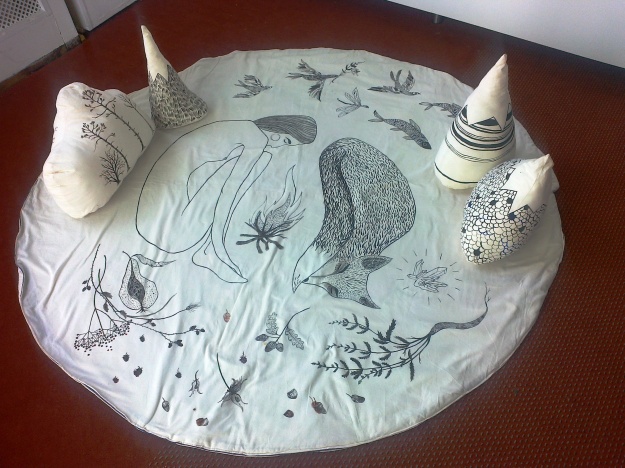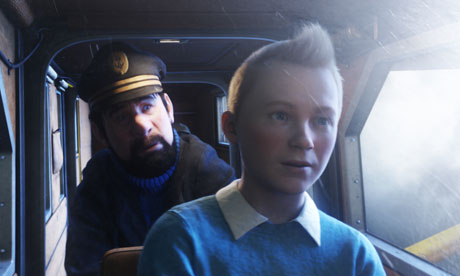Last weekend I headed to the lovely Falmouth in Cornwall for a day at the Performing Objects Conference, a four day symposium delving into the broad visual arts field inhabited by puppetry, digital puppetry, toy theatre, automata and more. I now attempt to translate a notebook of hurried scrawlings into a coherent report of the day.
The morning began with a Character and Story Development for Puppets workshop with Jonathan Leach, described in the programme as an illustrator – a modestly quiet and friendly young guy accompanied by a huge trunk. He proceeded to empty the trunk and cover the conference room table with a staggering selection of his puppets, ranging from waify little rod puppets to huge, mythical beings taller than him. All of them had an eerie, otherworldy look to them, with hand-stitched suede exteriors (which Leach enjoys working with so that the puppets can age over time), natural gems for eyes and, in some cases, real animal hair or fur. They were mysterious, beautiful and haunting puppets and I developed a particular crush on Hugo (below), an 1000yr old forest fawn with luxurious, silky goats hair and a jacket handsewn by Leach from dozens of tiny patchworked fabric strips. But the really interesting thing was the role served by Leach’s puppets – he’s an illustrator, not a puppeteer, and he brings his illustrations to life via his puppets in order to delve into their characters and develop his stories more deeply. (He first got into stories when, as a dyslexic school student, he was advised to turn his story ideas into scripts). This strange colony of beautifully-made puppets, acting as ‘intermediaries’ between the world of visual ideas and the blank page left a real imprint on me.

There was time for a brief visit to the Poly‘s Felicitous Objects exhibition, ‘a gathering of assorted performing objects’ in association with the conference. There was a range of impressive automata, several paper theatres and other interesting storytelling devices, but I was most struck by Sabine Beitzke‘s beautiful and unusual Embedded (see below), which appeared to me to be a cross between a traditional storytelling scroll and a sleeping bag – a unique, multi-sensory storytelling environment exploring the territory between illustration and performance.

In the afternoon, Jenny Romaine and John Bell of Great Small Works delivered a paper on Puppetry and Community Activism which put fascinating perspectives on their use of arcane folk theatre traditions such as toy theatre and carnival puppetry to express strong social and political messages on the streets of New York. Here is some footage from their 2010 Greatest Smallest Parade, a procession of miniature, handmade floats accompanied by a brass band through the streets of Brooklyn (this was whilst I was on an internship with the company – spot my mini Hundertwasser House float about 20 seconds in, and throughout the film!)
Romaine blew the minds of most of the people present at this seminar by introducing us to the term dazzle camouflage, explored in relation to political theatre in Ezra Nepon‘s brilliantly-titled MA thesis, Unleashing Power in Yiddishland and Faerieland: Spectacular Theatrical Strategies for Resistance and Resilience. Romaine told us that dazzle camouflage refers to a little known practice, during the First World War, of painting war ships with brightly coloured, contrasting patterns rather than trying to conceal them by painting them the standard sea-grey colour (see below). They took this seemingly odd approach on the basis that it made the enemy struggle to determine the ships’ speed, direction and position – instead of concealing themselves, these ships chose to draw attention to themselves and to then dazzle, baffle and confuse the enemy – and it seemed to work.

Analysing the idea of dazzle camouflage in relation to the arts and political activism opened up a whole colourful can of worms. In this era of post-modernism it is brave and perhaps a bit foolish to be colourful, vibrant, quirky and childish with your creative aesthetic – ‘highbrow’ culture prefers understated-ness and is wary of anything that comes across as a bit earnest. But by adopting a guise that is charming, aesthetically extravagant and playful, you are able to sneak your way into the Establishment via the side door and then reveal your underlying political messages in a quirky and ambivalent way, without causing hostility. When everyday people doing their shopping in a city centre see a typical demonstration taking place – glum faces, placards, tabards, etc – they often keep as much distance from it as possible because they find it unsettling and threatening. But when they see colours? Big papier mache, childishly-made folk art sculptures and puppets? People with painted faces performing, playing music, wearing costumes? A crowd of people of all ages will gather to enjoy it, and although a lot of them might just enjoy the visual and sensory entertainment, some people will quickly decipher the political message carefully embedded beneath the spectacle. By using the principle of dazzle camouflage artists can use popular, ‘lowbrow’ art forms (puppetry, carnival arts, circus arts…) to disarm, and charm, the general public and get their heavy messages across.
The afternoon ended with Colette Searls’ fascinating plenary address, Digital Puppetry – When Images Perform. Searls, an associate professor from the University of Maryland, explored the the principles of puppetry in relation to the current trend of mo-cap (motion capture) technology in blockbuster animation films such as Lord of the Rings, King Kong and Avatar, and articulated the essential problem she, and many other animators have with this increasingly popular technology.
In the beginning, Searls explained, there was the animated film – images and characters created entired through the animator’s imagination and drawing skills (whether by hand, or using computer animation software). It was completely different to non-animated films, of course, featuring actual human actors, and each type had its own unique merits – in animation, the limitless fantastical possibilities of the animator’s creativity, and in non-animation, the power of real actors. But the along came mo-cap, which involved getting actors (or, commonly puppeteers – who often have a heightened awareness of the mechanisms of human movement through learning how to manipulate puppets) to carry out physical movements and facial gestures with dozens of sensors stuck to their skin, enabling them to be translated directly into animated characters to make them incredibly human-like (see Zoe Saldana in Avatar, below).
![]()
This is amazing and very clever, and means that our animations are becoming even more amazing…right? Well, no, says Searls. As the line between the animated and real becomes increasingly blurred we encounter a problematic concept coined in 1970 by robotics professor Masahiro Mori – the uncanny valley. This term refers to the feeling of unease and disgust that humans experience when they see something that looks and moves almost, but not quite, like a human, and has also been explored by Freud in his 1919 essay The Uncanny. Take a look, for example, at the image below from the new animation Tin Tin, which uses some of the most advanced mocap technology yet. As discussed in this Guardian article, the characters are incredibly human-like but simultaneously there is something eerie, vacant and empty about them: as Searls puts it, ‘you can see the cladding but not the soul.’ Searls argues that this type of animation loses all the merits of traditional animation (the creativity), whist simultaneously losing the merits of non-animated films (human actors). When strong actors are translated into animated characters, such as Robin Wright in Beowolf, Searls argues that they are diminished to an ‘overlay’ of a face, and nothing more.

Searls’ point is that in order to avoid the uncanny valley animation has to return to its roots, and maintain a healthy distance from reality, between ‘the performer and the performed’. And of course anyone who makes, uses or appreciates puppets would probably agree with that.
As the talk came to an end, my mind was racing off in tangents thinking about the uncanny valley in relation to botox, and in relation to emoticons, those crass yellow faces with happy or sad expressions which have become so commonplace in text messages and on Facebook. It seems that in all areas of life we need a clear separation between that which is real, and that which isn’t – and that’s what allows us to truly suspend disbelief and harness our emotions.
